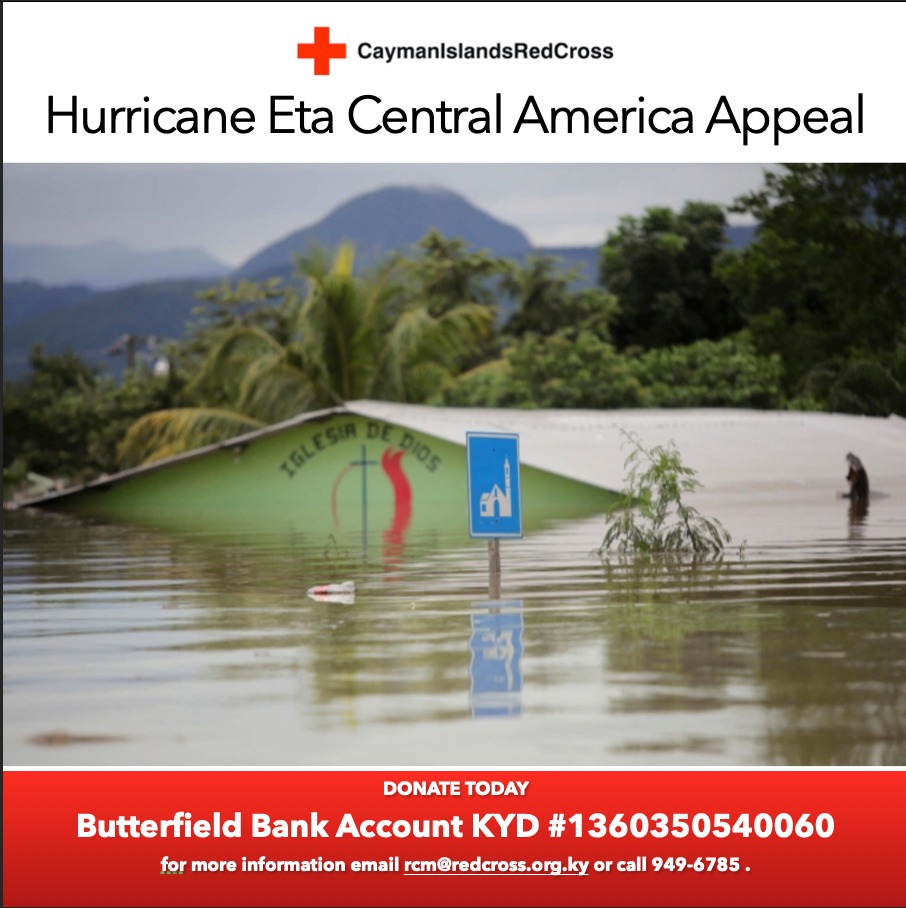
The Cayman Islands Red Cross has launched an appeal to support the victims of Hurricane Eta in Central America. While the full impact of the category 4 hurricane is not yet known, rapid initial assessments from Red Cross officials on the ground have identified as many as 1.7 million persons affected in Honduras, 30,000 persons in Nicaragua, and 144,000 persons affected in Guatemala.
The International Federation of the Red Cross (IFRC) released 1,000,000 Swiss francs from its Disaster Relief Emergency Fund (DREF) on November 4th to bolster the first wave of the Red Cross’ response in the territories. However, given the magnitude and impact of the storm a further 20 million Swiss Francs will be raised via the global appeal.
“To call 2020 a challenging year remains a gross understatement,” explains the Cayman Islands Red Cross Director Jondo Obi. “Here in Cayman, we experienced Eta as a Tropical Depression that passed 45+ miles away from us, and we saw just how vulnerable our Island was, especially in light of the rainfall that we had been experiencing prior to this storm. The photos emerging out of Central America following Eta’s path of destruction as far too familiar, and many of us who lived through Hurricane Ivan here cannot fathom having to respond to a disaster of this magnitude while facing a global health pandemic,” she continues. “The calls and inquiries have been coming in, especially given the ties which our community has to Central America, and we are always overwhelmed by the steadfast generosity of our community,” she adds.
The CIRC’s Eta Appeal will be limited to monetary donations only as this has been proven to be the best way to assist vulnerable people and to effectively respond to such crisis.“Globally we have decades worth of lessons learned and this has probably been the hardest lesson to
implement,” explains Deputy Director Carolina Ferreira. “Very well-intentioned people have, time and time again, created a ‘second disaster’ through the donation of unsolicited goods that has incredibly
serious consequences on the ground and for a really long time disaster response organizations have tip toed around this because they have been afraid of insulting people. Yet in this day and age of reducing,
reusing, and recycling it is important for people to know that unsolicited goods not only end up in dumps and landfills but also create major problems when it comes to getting necessary items to the places that need them,” she adds.
The issue of the “second disaster” associated with unsolicited goods pouring into disaster areas has been documented since the early 2000s, but it is a problem that has spanned decades. Reports have come out in the aftermath of just about every major disaster detailing the extent of the harm which unsolicited goods have created on the ground. In 1998, for example, in the aftermath of Hurricane Mitch in Honduras an airplane full of disaster supplies could not land because the runway was overrun with clothing donations. Photographs following the 2004 tsunami in Indonesia captured the mountains of used clothing that were donated but as they could not be distributed went toxic and was disposed of by the local government by pouring gasoline on it and setting it aflame, with the remnants going into the sea.
The Cayman Islands Red Cross also has first-hand experience dealing with unsolicited goods during Hurricane Ivan. “There were hours that were taken out of our day to clear goods from the airport that had arrived and we had no idea we were getting. Our vehicles, like many others, had all been damaged by the storm so we had to figure out a way to get to ORIA. Then the volunteers had to load everything and offload at our Headquarters where we really didn’t have much space for storage. Then came the sorting and that part was always mind blowing: winter coats, dirty underwear, and we even got one box of all left shoes. And the most disheartening part was knowing that we had people in real need that we
couldn’t get to as fast because our people had been diverted to deal with clearing out these donations which would ultimately end up in the landfill,” Ms. Ferreira recalls.
Monetary donations also have some additional benefits. In the immediate aftermath of a disaster, it allows organizations like the IFRC to get more out of the funds because existing agreements with key distributors and the need to purchase in bulk turns that $1 donation into $7. Furthermore, as the needs of the population change- and this can happen fairly quickly monetary donations allow organizations as well as the most vulnerable communities themselves the flexibility of meeting those needs by spending those funds on priorities. This also helps sustain local economies and
puts affected areas on the path to recovery much quicker, and given that most households and local economics are still reeling from the financial impact of COVID-19 this type of assistance helps to strengthen social protections which have a positive ripple effect throughout the community.
“At the end of the day, the decision to donate boils down to the question “for whom are you donating?”. When presented with all this information and evidence, people are making a choice between donating to make themselves feel better and donating to actually make a difference in the lives of survivors. We are doing our best to assist the most vulnerable based on what we have learned, which is why this has become our policy for running appeals,” Ms. Ferreira concludes.
Donations can be made to Butterfield Bank Hurricane Eta Central America Appeal account #1360350540060 or directly to the CI Red Cross office on Cayman Corporate Centre, 27 Hospital Road, 1st Floor.
For more information please contact the Red Cross on [email protected] or 949-6785.
